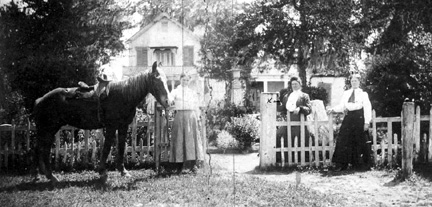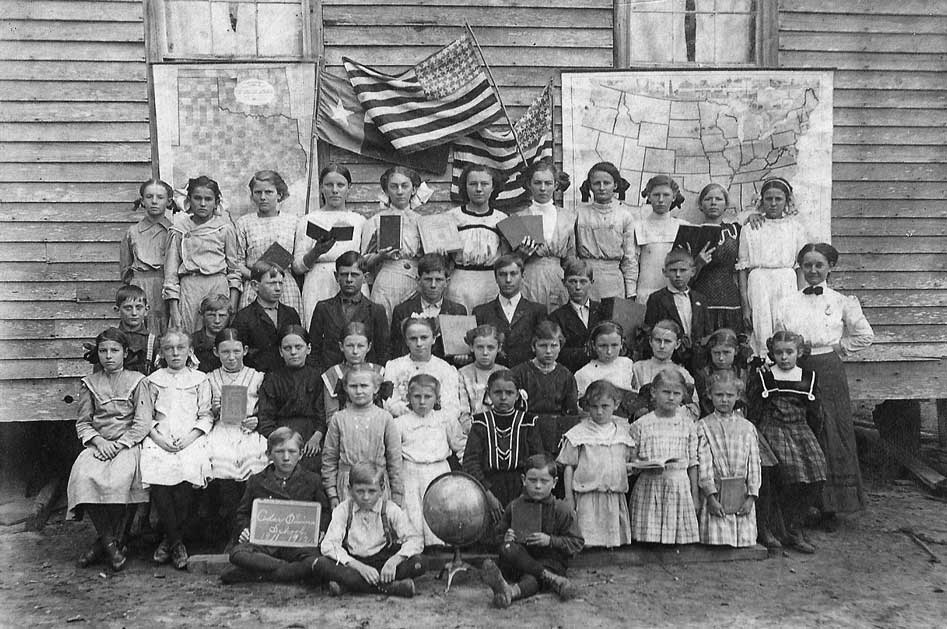About five miles west of La Grange lies the Cedar settlement. It lies on the La Grange Flatonia road on the north edge of the fertile Navidad Prairie. The name of Cedar was given to the settlement on account of the many cedars planted in its neighborhood. In old times, it used to be a very popular resort for amusement and it was known as such throughout the county. The land around Cedar is very fertile. The first settlers in the Cedar district were Bill Lewis, John Lewis, Ferrill, Dr. Denker [Dencker], Franke and Allen. They settled there in the forties. Cedar consists of a store, saloon and postoffice combined, also of one large hall. It has a physician. It is not a voting place, but is a post-office. The people vote at the Bluff box. The Cedar Maennerchor which holds its meetings at O'Quinn takes care of the social side of life. Cedar also has a lodge of the Sons of Hermann. The population of Cedar is mostly German.
From Historical Sites & Communities
Cedar was located on the La Bahia Road five miles west of La Grange on FM 609. This community is revealed only by its cemetery, but at one time was popular for being a resort for amusements. it was settled in the 18402 by the Lewis Family, Dr, Denker and others. It once had a store, post office, saloon and a large dance hall.
Dr. Friedrich Dencker's Daughters Julia (center) with Minna and Gertrude in front of the Dencker home six miles southwest of La Grange
Photo contributed by Mike Gohlke.
The Texas Monument Having ascended an eminence almost anstanter, we were at the excellent and well imporved farm of J. E. Lewis, Esq. While his dwelling is comfortable, he has a mill and gin in operation; and what adds to the interest, both of the Squire's farm and many others of the neighborhood, is, that they are enclosed with cedar rails. |
The La Grange Journal Editor, Journal: Cedar is situated five miles west of LaGrange, and is the centre of an industrious, thrifty and energetic community. The soil in this locality is black wax and sandy, and yields, in ordinary seasons, from one-half to one bale of cotton, thirty-five bushels corn, sixty bushels oats and from three hundred to four hundred bushels sweet potatoes per acre. The principal market for this neighborhood has been Schulenburg; but since the completion of the La Grange Branch, a noticeable change has taken place, which, no doubt, will be greatly increased, when the new iron bridge about to be erected over Buckner's Creek is completed. The topography of our locality is undulating and well suited to agriculture; no ponds or marshes here to generate minsma and breed sickness. It is no place for physicians; three having tried to build up a practice in the past six years had to abandon the place in disgust, not possessing the self sustaining powers of Dr. Tanner. As an evidence of the healthfulness of this locality, we will state that the first grave that was dug in our graveyard was in 1839, and the whole country for ten and fifteen miles around brought their dead there to be buried; yet from that time to the present it will not average more than two burials per year. |
Timber and building stone are abundant and plenty of good water can be had by digging from twenty to forty feet. Fruit culture in this vicinity is in its infancy, yet, with the same care and attention it receives in the North, would meet with better success than at present. The only one here that takes any pride in the cultivation of fruit is that enterprising and energetic farmer, Mr. Edward Spencer, who, in addition to the sixty acres he has under cultivation, has a small experimental orchard of apples, peaches, pears, etc., together with nearly a dozen different varieties of grapes. His peaches, pears and grapes have done excellent, but his apples have not done so well. This year he proposes sowing six acres in Austin grass as an experiment. Bee culture is beginning to come into favor in this neighborhood. Mr. Jessie Lewis, Mr. James Lewis and Mr. Mills are all interested in bee culture; but when it comes to the greatest number of hives, Mr. Jessie Lewis is the boss apiarist. Mr. Julius Mittman is our gentlemanly and accomodating merchant and postmaster, who has a well selected stock of goods that he should make known to the people generally by contributing an Ad to the columns of the Journal. Adjoining Mr. Mittman's store is the Concordia Hall, in which the "Club" occasionally assemble to "trip the light fantastic toe." The school at this place, presided over, and has been for the past five or six years, by Prof. Mills, who so far as is known, has given entire satisfaction to both parent and pupil. In our next writing we will give reminisences of some of our early settlers. CHIP |



